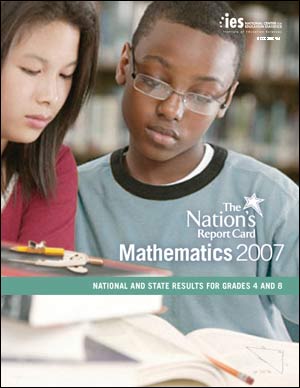
The Nation's Report Card: Mathematics 2007September 2007 Authors: Jihyun Lee, Wendy S. Grigg, and Gloria S. Dion Download sections of the report (or the complete report) in a PDF file for viewing and printing. 
Executive SummaryStudent groups make gains, few gaps narrow Both fourth- and eighth-graders reached a higher level of performance in 2007 compared to earlier assessment years. The 2007 National Assessment of Educational Progress (NAEP) evaluated students’ understanding of mathematics concepts and their ability to apply mathematics to everyday situations. Students demonstrated their knowledge of these critical skills by responding to questions about number properties and operations, measurement, geometry, data analysis and probability, and algebra. A nationally representative sample of more than 350,000 students at grades 4 and 8 participated in the 2007 mathematics assessment. Comparing these results to results from previous years shows the progress fourth- and eighth-graders are making both in the nation and in individual states. The average score for fourth-graders increased 27 points over the past 17 years, and the score for eighth-graders increased 19 points. Students at all levels of performance made gains, resulting in higher percentages of students at or above the Basic and Proficient achievement levels. Student groups make gains, few gaps narrowAs indicated in the chart on the following page, improvements for minority students did not always result in narrower achievement gaps with White students. White, Black, and Hispanic students at both grades showed a better understanding of mathematics in 2007 when compared to all previous assessment years. However, when compared to the first assessment year in 1990, only the White – Black score gap at grade 4 narrowed in 2007. The White – Black score gap at grade 8 narrowed between 2005 and 2007. The mathematics score for Asian/Pacific Islander students was higher in 2007 than in previous assessment years for grade 4, but at grade 8 showed no significant change from 2005 to 2007.
At both grades 4 and 8, scores rose for students regardless of their eligibility for the free and reduced-price school lunch program, a measure of socioeconomic status. Average scores were higher in 2007 than in 2005 for students who were eligible as well as for students who were not eligible.
Download sections of the report (or the complete report) in a PDF file for viewing and printing:
NCES 2007-494 Ordering information For more information, see the results of the 2007 Mathematics assessment on the Nation's Report Card website.
|
||||||||||||||||||||||||||||||||||||||||||||||||||||||||||||||||||||